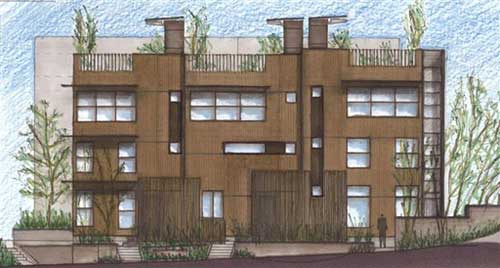Coveting Half

[ Conceptual rendering of Footprint at the Bridge project — Johnston Architects ]
The Bridge Motel enjoyed a well-publicized, dramatic demise, and potentially, what’s to replace it will also warrant some notoriety. Not for the design–though since it is being designed by Johnston Architects it will likely be well done–but for the project’s goal of achieving a 50% reduction in energy use compared to a similar building that meets Washington State energy code.
Cutting building energy use in half may be an ambitious goal, but we should be pushing for goals like this in every new building that goes up. And the AIA’s 2030 Challenge does just that, calling on architects and engineers to design all new buildings for 50% energy use reduction starting now, and then to ratchet energy use down to net-zero consumption by 2030.
The Footprint at the Bridge project website provides a long list of energy saving strategies that will be applied. Nothing on the list is particularly radical, but what will be unusual is the inclusion of all of them in one building. Seattle firm Ecotope is providing energy consulting for the project.

[ Conceptual rendering of Footprint on Main project — Johnston Architects ]
The rendering above shows a second project in the works by Footprint Developments, located at the corner of 23rd and Main in the Central District. The goal for this 4-story residential building is a 60% reduction in energy use, which is the 2030 Challenge target for the year 2010. The web site shows a list of energy saving strategies that is almost identical to the list for the Footprint at the Bridge project.
It will be enlightening to see if these two projects can be integrated with all the proposed design features and achieve their energy goals without incurring prohibitive marginal construction costs. For comparison, a few other projects with significant energy savings targets that have been noted on this blog:
- Issaquah Net-Zero Energy Homes
- LEED townhouses: 30 to 50% reduction
- Weber Thompson HQ: 30% reduction
If any readers know of other projects in the Seattle area that are pushing the envelope on energy efficiency, please leave a comment. In particular, real-world projects such multifamily buildings would be more relevant to this discussion than trophy projects such as the Seattle Public Library.
